|
Our exploration
of the OW Ranch Site will conclude with some new images and finds!
The site did not pan out for a good locality for silicified microfossils
because the preservation was very poor because the fossils were
only partially silicified. Many fragments of fossils came out
of the Muriatic bath (HCl).
Recently, on a trip
to the Home Depot store, we found they sold some very strong
acetic acid, 30% compared with the supermarket strength of about
4 percent. We though we would try it on some residual pieces
of the limestone we had from breaking rocks apart with a hand
sledge. Acetic acid, as you know is much safer than Muriatic.
It also does not burn up organic material like bones, and conodonts
jaws. It was hoped we might find a few of these in the acid residues!
It is very slow going, since it is much weaker but after a few
weeks we knew it was worth the effort. Several button like fish
teeth were recovered, and some really surprising other material
as well. But no conodonts.
Click to enlarge to
full size:
Trilobites:
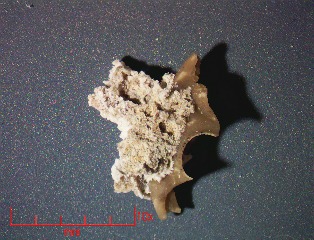 |
Phillipsia
sp. This is
the left side of the cranidium, or free cheek. The genial spine
is at bottom, and the big round cut out on the right edge - is
the cut out for the trilobites eye. At top is the dorsal rim
that outlines the front of the animal. Unfortunately, a lot of
silica was still attached to the left side and obscures it a
bit. Still, we were not expecting to find this in a few broken
chips left over from our rock cracking. |
Plant Cuticle:
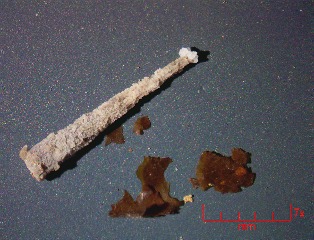 |
Several items
seen in this image. On the top is an urchin spine, tipped with
a little circlet of quartz crystals. But the major find here
is the land plant cuticle! This is of course the waxy protein
coat on the plants leaf cells to seal them from water loss. Cuticle
is tough and resilient and can be found in both marine and terrestrial
deposits, and usually has impressions of leaf veins and such
impressed on their inner face.
This material is
not a contaminant from the outside. It came out of a fresh batch
of well rinsed limestone and from near the very core of the rock,
not the outside. There is no doubt it was in the Fort Apache
Sea and buried along with the marine fossils.
|
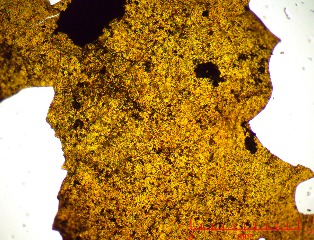 |
Plant
Cuticle. A
series of close ups of the cuticle under a transmission optical
microscope. |
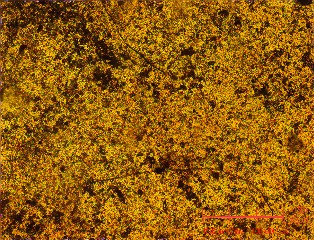 |
Plant
Cuticle. Scale
at bottom of all these images. |
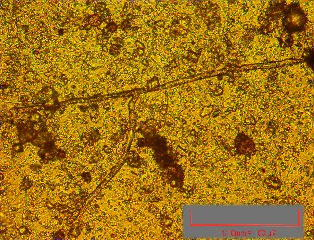 |
Plant
Cuticle. Leaf
veins preserved in the cuticle! |
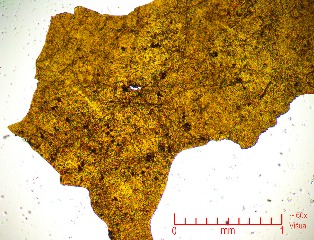 |
Plant
Cuticle. Piece
with leaf veins. |
Foram:
-1-comp-L-320.jpg) |
indet
sp. A small
piece of blue material that was the size of a grain of sand was
spotted under the stereo microscope when examining the acid fines.
This has never been seen before in the stronger muriatic acid
fines. Close examination with the powerful trinocular microscope
and top lit with a powerful halogen fiber optic lamp, we can
see intricate details. The blue is most likely some copper mineral,
and the red spots maybe cuprite. But on closer examination -
a surprise was waiting.... |
-2-compL-320.jpg) |
Foram.
For this much
higher power view, we can now see a round disk shaped foram was
embedded in the mineral. Look even more closely and you can see
small indentations all over its surface. None of this would have
been recovered in the muriatic acid. |
Fish Teeth:
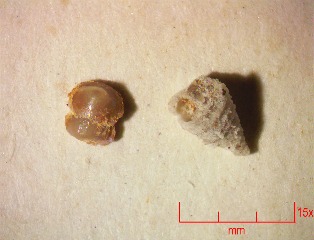 |
Fish
Teeth and Gastropod. As
you can see by the tiny gastropod with has very poor preservation,
this material is not so great for fossil recovery of mollusks.
But for the VERY FIRST TIME we found this gorgeous tiny
fish tooth in the acid fines. It is actually two stuck together
here, they are cap shaped and are the type that would have been
used to crush the numerous gastropods and clams found in this
formation. The actual fish would have been quite small, about
2-3 inches long like a minnow. |
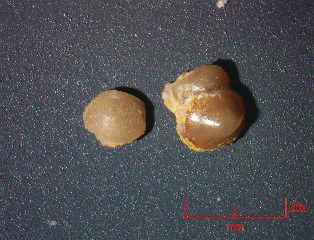 |
Fish
Teeth. A total
of two separate sets of teeth found. You can clearly see the
capped dome shape on the right one. |
Quartz Crystals:
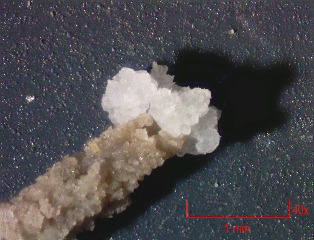 |
On
the tip of one urchin spine, a ring of interesting milky quartz
crystals was seen. The spine itself is very badly preserved and
is really rough looking! |
|
